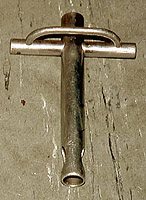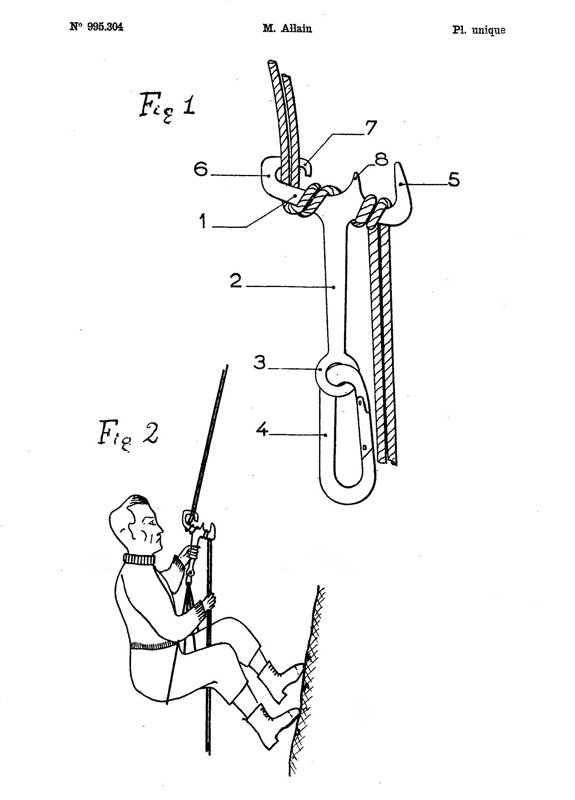Overview
[ Top
| Version B
| Return to Hooks
]
Version A
(#1084)
Technical Details
I acquired this descender from Stéphane Pennequin in
2007.
The Pierre Allain, Version A is a single piece forged aluminum
descender. This Pierre Allain is 188 mm. high, 11 mm.
wide, and 17 mm. thick. My Version A is somewhat worn,
and weighs 149.
Unlike the far more common Version B, Version A has
a flat (milled) shaft. The two sides of the shaft are marked "PIERRE
ALLAIN" and "BREVETE SGDG," respectively. The letters
are shallow and indistinct, in marked contrast to those on Version B.
Aside from the differences in the shaft, the two versions are
remarkably similar.
 Pierre Allain filed for a French patent on September 15, 1949, and received Patent #995,304 in 1951. I can trace Version B back to 1960, allowing us to bound the age of Version A. It is, therefore, a very old design that is too valuable for me to test, let alone relegate to
general use.
Pierre Allain filed for a French patent on September 15, 1949, and received Patent #995,304 in 1951. I can trace Version B back to 1960, allowing us to bound the age of Version A. It is, therefore, a very old design that is too valuable for me to test, let alone relegate to
general use.
Despite its age, it is not the oldest Pierre Allain descender
design. Stéphane Pennequin sent me a photo of a 1947 prototype that is actually, in some sense, a figure eight. Pierre Allain made only one prototype.
[ Top
| Version A
| Return to Hooks
]
Version B
(#366, 578, 1279, 1329, 3211)
Technical Details
I acquired this descender from Pathfinder Sports in 1982. I
acquired a second one from John E. Weinel, Inc. in 2000, a third from Kevin Raymer in 2011, a fourth from Paul Calton in 2012, and a well-used fifth from Gary LeMacs in 2022.
The Pierre Allain, Version B is a single piece forged
aluminum descender that works on the same principal as a horizontal
spool. The rope is wrapped around a slightly tapered arm that
is inclined about 28° to the horizontal. The arm has a hook
and two horns on the upper side that keep the rope in position.
A shaft extends 100 mm. below the arm to an attachment eye
with a 16.3 mm. hole. The shaft is inclined about 8°
from the vertical. This Pierre Allain is 188 mm. high, 103 mm.
wide, and 17.5 mm. thick. My descender is somewhat worn,
and weighs 144.5 grams, so I estimate that the original weight
was 145 to 150 grams.
The two sides of the shaft are marked "PIERRE ALLAIN"
and "BREVETE SGDG," respectively. The previous owner
of the first descender engraved the initials "RCB" in
the device. I believe that this was Roland C. Brown’s personal
descender. Roland was a salesman at Pathfinder Sports that helped
me acquire several devices for my collection. The one in the photo is the one that I acquired from John E. Weinel, Inc.
This descender appears in Pierre Allain’s 1956 book L’art de l’alpinisme, but the drawings do not allow me to determine which version he illustrated. The drawing on the back cover of the April-June 1960 issue (#47) of Mountain Craft clearly matches Version B far better than Version A. The earliest American reference to this descender I've found
is in the 1961 REI catalog, and it looks more like Version B than A. I have not been able to check a 1960
catalog, but it did not appear in the 1959 catalog. In the caving
literature, it appeared in the Humor section of the October 1964
Windy City Speleonews. That article suggests a number of appropriate
uses for the Pierre Allain descender, none of which involve rappelling.
The Pierre Allain seems to be more secure than
it appears, but I cannot recommend it as a safe device for general
caving. First, the thin shaft does not have a large enough cross
section to for me to fully trust it. Second, the rope can come
off the arm if the rappeller is not careful. This is particularly
true with some of the modern caving ropes, such as PMI, which
tend to be stiffer than climbing ropes. One can, of course, increase
security by rigging differently, but I've never seen this method
published. The alternate rigging is the similar to the way one
should rig a Rappel Hammer:
bring the rope down under the hook and around the other side of
the horizontal arm, pass it under the arm, 180° around the
vertical shaft, and then back up and over the top of the arm,
between the two spikes. The Pierre Allain is a classic device
that appears in many of the older climbing books, so it makes
a good addition to any equipment collection - which is where it
should stay.
 |
[ Top
| Version A
| Version B
]



 Pierre Allain filed for a French patent on September 15, 1949, and received
Pierre Allain filed for a French patent on September 15, 1949, and received 